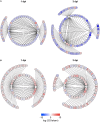E2F4 Promotes Neuronal Regeneration and Functional Recovery after Spinal Cord Injury in Zebrafish
- PMID: 27242526
- PMCID: PMC4860404
- DOI: 10.3389/fphar.2016.00119
E2F4 Promotes Neuronal Regeneration and Functional Recovery after Spinal Cord Injury in Zebrafish
Abstract
Mammals exhibit poor recovery after spinal cord injury (SCI), whereas non-mammalian vertebrates exhibit significant spontaneous recovery after SCI. The mechanisms underlying this difference have not been fully elucidated; therefore, the purpose of this study was to investigate these mechanisms. Using comparative transcriptome analysis, we demonstrated that genes related to cell cycle were significantly enriched in the genes specifically dysregulated in zebrafish SCI. Most of the cell cycle-related genes dysregulated in zebrafish SCI were down-regulated, possibly through activation of e2f4. Using a larval zebrafish model of SCI, we demonstrated that the recovery of locomotive function and neuronal regeneration after SCI were significantly inhibited in zebrafish treated with an E2F4 inhibitor. These results suggest that activation of e2f4 after SCI may be responsible, at least in part, for the significant recovery in zebrafish. This provides novel insight into the lack of recovery after SCI in mammals and informs potential therapeutic strategies.
Keywords: DREAM complex; E2F4; comparative transcriptome analysis; spinal cord injury; systems pharmacology; zebrafish.
Figures





Similar articles
-
Non-mammalian model systems for studying neuro-immune interactions after spinal cord injury.Exp Neurol. 2014 Aug;258:130-40. doi: 10.1016/j.expneurol.2013.12.023. Exp Neurol. 2014. PMID: 25017894 Free PMC article. Review.
-
Major vault protein promotes locomotor recovery and regeneration after spinal cord injury in adult zebrafish.Eur J Neurosci. 2013 Jan;37(2):203-11. doi: 10.1111/ejn.12038. Epub 2012 Oct 28. Eur J Neurosci. 2013. PMID: 23106570
-
Ptena, but not Ptenb, reduces regeneration after spinal cord injury in adult zebrafish.Exp Neurol. 2014 Nov;261:196-205. doi: 10.1016/j.expneurol.2014.06.006. Epub 2014 Jun 11. Exp Neurol. 2014. PMID: 24929056
-
Beneficial roles of melanoma cell adhesion molecule in spinal cord transection recovery in adult zebrafish.J Neurochem. 2016 Oct;139(2):187-196. doi: 10.1111/jnc.13707. Epub 2016 Jul 12. J Neurochem. 2016. PMID: 27318029
-
Regeneration of Spinal Cord Connectivity Through Stem Cell Transplantation and Biomaterial Scaffolds.Front Cell Neurosci. 2019 Jun 6;13:248. doi: 10.3389/fncel.2019.00248. eCollection 2019. Front Cell Neurosci. 2019. PMID: 31244609 Free PMC article. Review.
Cited by
-
C3orf70 Is Involved in Neural and Neurobehavioral Development.Pharmaceuticals (Basel). 2019 Oct 16;12(4):156. doi: 10.3390/ph12040156. Pharmaceuticals (Basel). 2019. PMID: 31623237 Free PMC article.
-
The Stress Response of the Holothurian Central Nervous System: A Transcriptomic Analysis.Int J Mol Sci. 2022 Nov 2;23(21):13393. doi: 10.3390/ijms232113393. Int J Mol Sci. 2022. PMID: 36362181 Free PMC article.
-
Identification of key genes involved in recovery from spinal cord injury in adult zebrafish.Neural Regen Res. 2022 Jun;17(6):1334-1342. doi: 10.4103/1673-5374.327360. Neural Regen Res. 2022. PMID: 34782579 Free PMC article.
-
Novel functions for the transcription factor E2F4 in development and disease.Cell Cycle. 2016 Dec;15(23):3183-3190. doi: 10.1080/15384101.2016.1234551. Epub 2016 Oct 18. Cell Cycle. 2016. PMID: 27753528 Free PMC article. Review.
-
Generation of a Triple-Transgenic Zebrafish Line for Assessment of Developmental Neurotoxicity during Neuronal Differentiation.Pharmaceuticals (Basel). 2019 Sep 24;12(4):145. doi: 10.3390/ph12040145. Pharmaceuticals (Basel). 2019. PMID: 31554324 Free PMC article.
References
LinkOut - more resources
Full Text Sources
Other Literature Sources
Molecular Biology Databases

